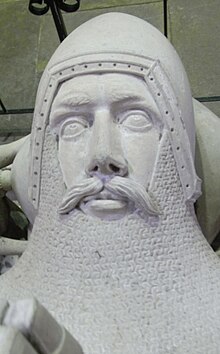Hugh de Courtenay, 10th Earl of Devon
| Hugh de Courtenay, 2nd/10th Earl of Devon | |
|---|---|

Effigy (restored) of Hugh de Courtenay, 2nd/10th Earl of Devon, south transept, Exeter Cathedral
|
|
| Born | 12 July 1303 |
| Died | 2 May 1377 (aged 73) |
| Noble family | House of Courtenay |
| Spouse(s) | Margaret de Bohun |
|
Issue
Sir Hugh Courtenay, KG
Thomas Courtenay Sir Edward Courtenay Robert Courtenay William Courtenay, Archbishop of Canterbury Sir Philip Courtenay Sir Peter Courtenay, KG Humphrey Courtenay Margaret Courtenay (the elder) Elizabeth Courtenay Katherine Courtenay Joan Courtenay Eleanor Courtenay Guinora Courtenay Isabel Courtenay Philippa Courtenay Margaret Courtenay (the younger) |
|
| Father | Hugh de Courtenay, 1st/9th Earl of Devon |
| Mother | Agnes de Saint John |
Sir Hugh de Courtenay, 2nd/10th Earl of Devon (12 July 1303 – 2 May 1377), 2nd Baron Courtenay, feudal baron of Okehampton and feudal baron of Plympton, played an important role in the Hundred Years War in the service of King Edward III. His chief seats were Tiverton Castle and Okehampton Castle in Devon. The ordinal number given to the early Courtenay Earls of Devon depends on whether the earldom is deemed a new creation by the letters patent granted 22 February 1334/5 or whether it is deemed a restitution of the old dignity of the de Redvers family. Authorities differ in their opinions, and thus alternative ordinal numbers exist, given here.
Hugh de Courtenay was born on 12 July 1303, the second son of Hugh de Courtenay, 1st/9th Earl of Devon (1276–1340), by his wife Agnes de Saint John, a daughter of Sir John de Saint John of Basing, Hampshire. He succeeded to the earldom on the death of his father in 1340. His elder brother, John de Courtenay (c.1296-11 July 1349), Abbot of , as a cleric was unmarried and although he succeeded his father as feudal baron of Okehampton, did not succeed to the earldom.
By his marriage to Margaret de Bohun in 1325, Courtenay acquired the manor of Powderham; it was later granted by Margaret de Bohun to one of her younger sons, Sir Philip Courtenay (died 1406), whose family has occupied it until the present day, and who were recognised in 1831 as having been de jure Earls of Devon from 1556.
On 20 January 1327 Courtenay was made a knight banneret. In 1333 both he and his father were at the Battle of Halidon Hill. He was summoned to Parliament on 23 April 1337 by writ directed to Hugoni de Courteney juniori, by which he is held to have become Baron Courtenay during the lifetime of his father. In 1339 he and his father were with the forces which repulsed a French invasion of Cornwall, driving the French back to their ships. The 9th Earl died 23 December 1340 at the age of 64. Courtenay succeeded to the earldom, and was granted livery of his lands on 11 January 1341.
...
Wikipedia
